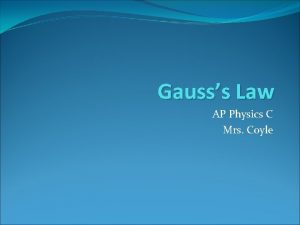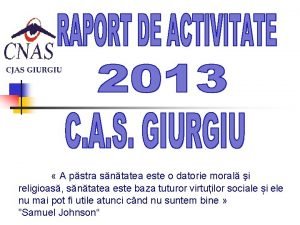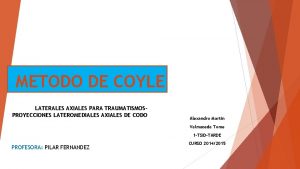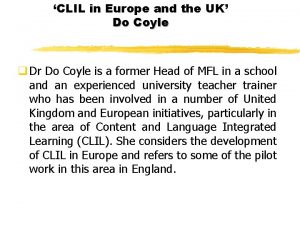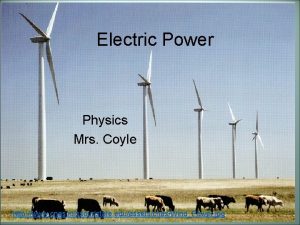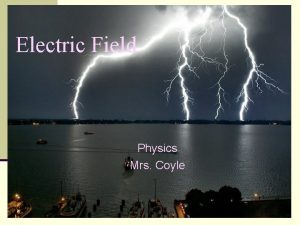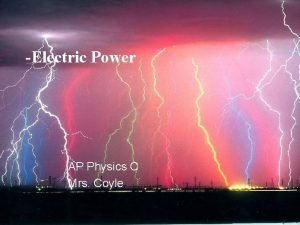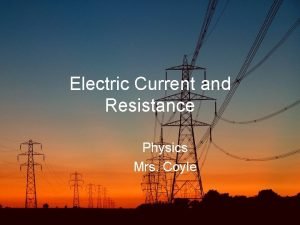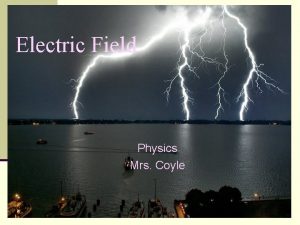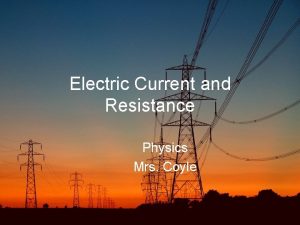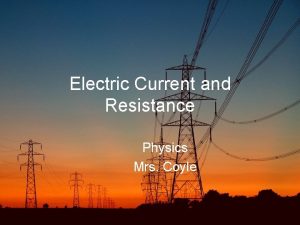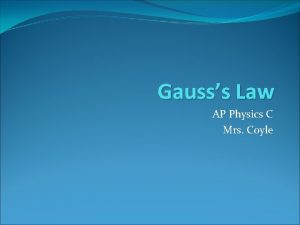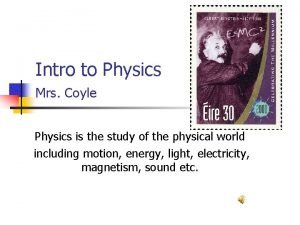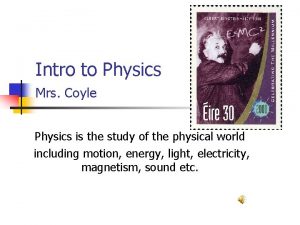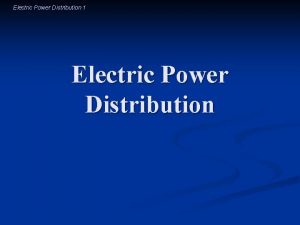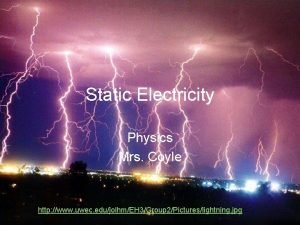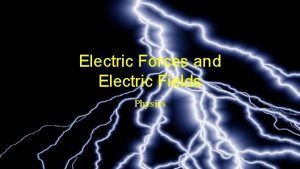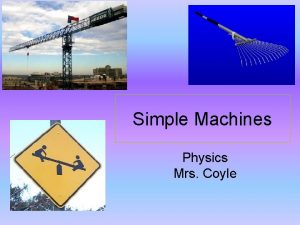Electric Power Physics Mrs Coyle http www cnas


























- Slides: 26

Electric Power Physics Mrs. Coyle http: //www. cnas. missouristate. edu/assets/cnas/Wind_Power. jpg

Part I • Electrical Power • Joule’s Law • Thermal Energy Expended by a Resistor

Wind Generator

Generator

Generator

Niagara Falls Hydroelectric Plant http: //www. niagarafallslive. com/images/NY_Hydro_Electric_Plant. JPG

Hydroelectric Power Plant

Remember: P= W / t (Power=Work/time) • Remember: W= Vq and I = q/t So: P= I V

Electric Power, P= I V Known as Joule’s Law P: is the power consumed by a resistor, R. Unit: Joule/s= Watt

Derive the following using P=IV and Ohm’s Law: P=V 2/R P=I 2 R

Problem 1 • The current through a car motor is 150 A. The battery used is 12 V. How much energy is supplied by the battery in 5 s? Answer: 9, 000 J

k. Wh kilo. Watt hour What does the k. Wh measure, a) Energy or b) Power ?

Problem 2 A small desktop radio has a resistance of 8, 000 Ω. The voltage is 120 V. a) How much current does it draw? b) How much power does it use? c) How much does it cost to run the radio for 12 hours, if 1 k. Wh costs $0. 15? Answers: a)0. 015 A, b)1. 8 W, c) $0. 00324

Resistors Expend Thermal Energy • Wasted heat energy is called “Joule Heating” or “I 2 R” loss.

Why is long distance power transmitted at high voltages? • Hint: P = I V • Answer: For a given P, keep the current, I, low to minimize “I 2 R” loss in the transmitting wires, so increase V.

Electric heaters(Coil Heaters) • P= V 2/R • The lower the R the greater the heat given off by the resistor for a given voltage.

Problem 3 • An electric heating element has a resistance of 9 Ω. The voltage is 120 V. a) Calculate the current through the element. b) Calculate thermal energy supplied by the element in 10 min. Answer: a)13. 3 A, b) 9. 6 x 105 J

Part II • Brightness of a Lightbulb • Some Safety Issues

Light Bulb

Brightness of a Light bulb and Power • The greater the power actually used by a light bulb, the greater the brightness. • Note: the power rating of a light bulb is indicated for a given voltage and the bulb may be in a circuit that does not have that voltage.

Wattage and Thickness of Filament • For a given V, (P = IV) the higher the wattage of a light bulb, the larger the current and therefore the smaller the resistance of the filament (V=I R). • Thus, the higher wattage bulb will have a filament of lower resistance and therefore a larger cross-sectional area (R=ρ L / A).

Question • Which light bulb has a thicker filament, 60 W or 75 W? • Answer: 75 W

Problem 4 A 60 W light bulb is 22% efficient. How much energy is lost to heat in 5 min? Answer: 1. 4 x 104 J

Safety Issues • Why is it not safe to handle electric appliances with wet hands? • Hint: • A current of 15 m. A can cause serious injury. • The resistance of a dry human body is in the range of 100, 000Ω. The resistance of a wet person can drop to the range of 5, 000Ω.

Problem 5 • A current of 1 m. A can be felt by a person. Will a person feel the current if the person has dry hands (a resistance of 100, 000 Ω) and touches a 9 V battery’s terminals? • Answer: I=0. 09 m. A, No.

Problem 6 • The same 9 V battery is touched by a person with wet hands. Will this person feel the current if the resistance is 5, 000Ω and the person touches the battery’s terminals? • Answer: I=1. 8 m. A, Yes
 Coyle electric
Coyle electric Adl coding for cnas
Adl coding for cnas Pradaxa protocol cnas
Pradaxa protocol cnas Cnas calarasi
Cnas calarasi Casa de sanatate giurgiu
Casa de sanatate giurgiu They are mrs garcia and mrs castro
They are mrs garcia and mrs castro They are mrs garcia and mrs castro
They are mrs garcia and mrs castro Mrs. darling was ___________ of mrs. s.
Mrs. darling was ___________ of mrs. s. Real power formula
Real power formula Coyle view
Coyle view Coyle method
Coyle method Coyle and castello method
Coyle and castello method Caitlin coyle
Caitlin coyle Do coyle
Do coyle Coyle bernard
Coyle bernard Coyle
Coyle Coyle health and wellbeing
Coyle health and wellbeing Aaron coyle
Aaron coyle Goethe mindmap
Goethe mindmap Dr christine coyle
Dr christine coyle Electric potential energy
Electric potential energy Potential and potential difference
Potential and potential difference Electric field lines
Electric field lines Electric potential is
Electric potential is A suitable electric pump in an electric circuit is a
A suitable electric pump in an electric circuit is a Chapter 21 electric charge and electric field
Chapter 21 electric charge and electric field Chapter 21 electric charge and electric field
Chapter 21 electric charge and electric field
